Every organisation has a myriad of stakeholders that influence the way it operates. When it comes to environmental, social and governance (ESG) efforts, it’s important to optimise stakeholder engagement throughout the process to identify high-priority and high-impact areas to focus on. Stakeholders include your:
- People
- Communities
- Customers/clients
- Suppliers
- Regulators and industry groups
- Governments
- Financers.
(Click to enlarge)
ESG questions and feedback
Your stakeholders’ opinions matter. Organisations working toward improving their sustainability and transparency efforts should prioritise engagement with those stakeholders who have the greatest influence and interest in their ESG processes. They are who will help drive efforts toward more sustainable operations. Without stakeholder engagement, managing risk around access to market, capital and talent is impossible.
Organisations can determine what matters most to their stakeholders by asking them specific questions like:
- How important is emissions reduction to you?
- How important is waste management to you?
- How important is water consumption to you?
Questions should also provide views on community engagement, including:
- How important are efforts regarding diversity and inclusion?
- How important are efforts regarding sustainability across your supply chain?
Stakeholder views across the ESG ecosystem
Once you understand the specific views of your organisation’s stakeholders and engagement across the entire ESG ecosystem, your leadership team can manage feedback and start addressing identified needs. The best way to prioritise your stakeholders is by considering their feedback and categorising them in terms of influence and interest in ESG efforts.
Tier 1 stakeholders: They hold significant influence and interest in the organisation’s sustainability operations. This group should be high-touch and high-priority, with one-on-one or small group meetings and frequent communication.
Tier 2 stakeholders: This group’s opinions and guidance matter, but they don’t have as heavy an impact. Their feedback should be given great consideration, but they don’t require the same amount of time and attention as Tier 1 stakeholders.
Tier 3 stakeholders: These stakeholders are interested in your organisation and efforts but hold less influence. While their opinions should be taken into consideration, they don’t significantly impact the prioritisation of your operations.
Tier 4 stakeholders: This group has moderate influence and moderate interest. They simply require updates and information about the ESG process along the way.
Remember, your organisation can’t be all things to all people - there are far too many stakeholders to engage equally and fully with. Identify what is important to your organisation, then identify what is important to your stakeholders. Wherever there’s overlap, that’s where you find your high-priority next steps.
BDO is offering a series of ESG: Opportunities & Risks for Boards webinars on behalf of Women on Boards. This workshop series will provide what you need to know about key ESG topics and concepts to fulfil your duties as an organisational leader or director.
Register or learn more about the webinar series today.
